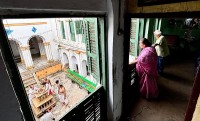nil
RBI cuts key rates to boost economy
Mumbai, Jun 2 (IBNS) To boost the sluggish economy, the Reserve Bank of India (RBI) on Tuesday cut its key policy interest rate by 25 basis points from 7.5 per cent to 7.25 per cent with immediate effect;
Presenting its second Bi-monthly Monetary Policy Statement, 2015-16, RBI Governor Dr. Raghuram G. Rajan said on the basis of an assessment of the current and evolving macroeconomic situation, it has been decided to reduce the policy repo rate under the liquidity adjustment facility (LAF) by 25 basis points from 7.5 per cent to 7.25 per cent with immediate effect.
He said there are mixed signs of economic recovery and risk to inflation remains still.
The RBI also kept the cash reserve ratio (CRR) of scheduled banks unchanged at 4.0 per cent of net demand and time liabilities (NDTL);
continue to provide liquidity under overnight repos at 0.25 per cent of bank-wise NDTL at the LAF repo rate and liquidity under 14-day term repos as well as longer term repos of up to 0.75 per cent of NDTL of the banking system through auctions; and continue with overnight/term variable rate repos and reverse repos to smooth liquidity.
Consequently, the reverse repo rate under the LAF stands adjusted to 6.25 per cent, and the marginal standing facility (MSF) rate and the Bank Rate to 8.25 per cent.
RBI said investment still remains weak.
Banks should pass on the rate cuts to consumers, said the RBI governor.
RBI said since the first bi-monthly monetary policy statement of 2015-16 issued in April 2015, incoming data suggest that the global recovery is still slow and getting increasingly differentiated across regions.
In the United States, the economy shrank in Q1 owing to harsh weather conditions, the strength of the US dollar weighing on exports and a decline in non-residential fixed investment. In the euro area, financial conditions have eased due to the European Central Bank’s (ECB) quantitative easing and a depreciating euro.
There has, however, been some moderation in composite purchasing managers’ indices (PMI), economic sentiment and consumer confidence in April.
In Japan, growth surprised on the upside in Q1, supported by private demand as business spending boosted inventories and personal consumption. For most emerging market economies (EMEs), macroeconomic conditions remain challenging due to domestic fragilities, exacerbated by bouts of financial market turbulence. China continues to decelerate in spite of monetary easing.
The third bi-monthly monetary policy statement will be announced on August 4, 2015.
Top Headlines
-
News
CSR in the Crossfire: Professor and practitioners debate over ethics in India Inc. at Kolkata's MCHD talk
October 24, 2025
-
News
Jashanpreet Singh Case: California under fire for licensing undocumented truck driver
October 24, 2025
-
News
India upgrades Technical Mission in Kabul to Embassy, days after Muttaqi's visit to New Delhi
October 22, 2025
-
News
Pakistan, Afghanistan agree to 48-hour ceasefire after deadly border clashes
October 15, 2025
-
News
Afghan Taliban, Pakistan exchange gunfire, dozens killed
October 15, 2025
-
News
Trump hails Netanyahu in Israel after hostage release, declares historic dawn of a new Middle East
October 13, 2025
-
News
Historic dawn of a new Middle East: Donald Trump addresses Israeli Parliament
October 13, 2025
-
News
Shah Rukh Khan receives maiden National Award from President Droupadi Murmu
September 23, 2025
-
News
Kolkata: Ahiritola Yubak Brinda invites Auram to make jewellery for Ma Durga and her family
September 20, 2025
-
News
Israel-US alliance 'never been stronger', Netanyahu says as State Secretary Rubio visit for talks
September 15, 2025





